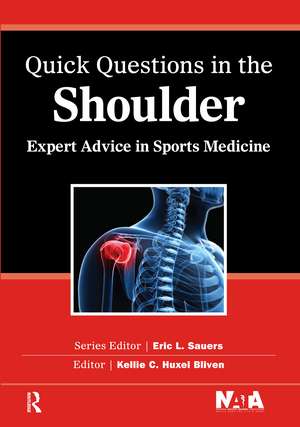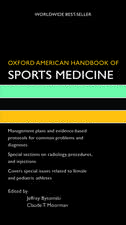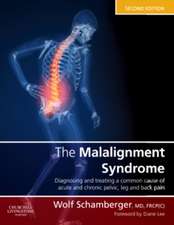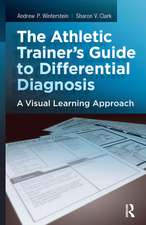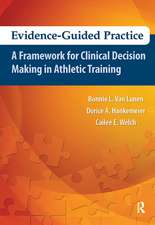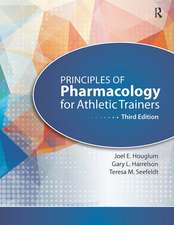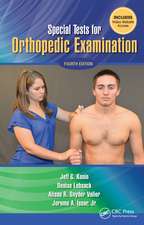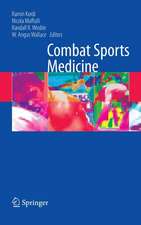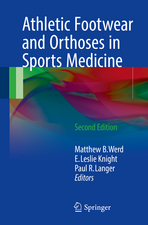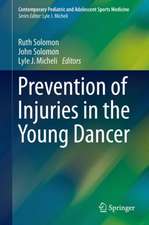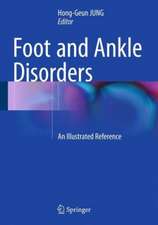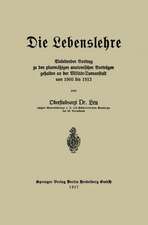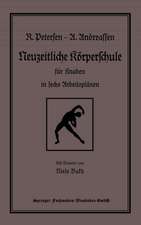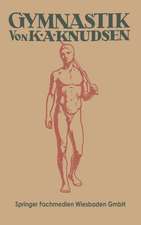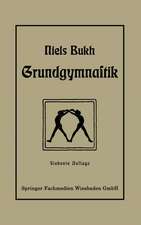Quick Questions in the Shoulder: Expert Advice in Sports Medicine: Quick Questions in Sports Medicine
Autor Kelly Blivenen Limba Engleză Paperback – 15 mai 2015
Are you seeking brief, up-to-date, expert advice for common issues that can be encountered when working with athletes?
Quick Questions in the Shoulder: Expert Advice in Sports Medicine provides a unique format of concise and to the point responses with clinical application, backed by the latest research on shoulder injuries among athletes.
Dr. Kellie C. Huxel Bliven and her contributors present 39 common clinical questions regarding the prevention, assessment, treatment, management, and rehabilitation of the shoulder.
Co-published with the National Athletic Trainers’ Association, Quick Questions in the Shoulder: Expert Advice in Sports Medicine provides concise answers to 39 frequently asked clinical questions. Written in a conversational tone, the authors of the individual questions represent a variety of different backgrounds and are experts in their respective field. The variety of questions and brevity of responses will make this a book that is easy to read and reference at the point of care.
Some sample sections and questions include:
- Factors related to shoulder function
- How does the trunk contribute to upper extremity function and injury risk in overhead athletes?
- Injury diagnosis
- What are the best clinical tests for determining if a patient has scapular dyskinesis and to determine if it is contributing to their shoulder pain and dysfunction?
- Injury treatment and rehabilitation
- What are the most effective glenohumeral mobilization techniques and when are they most appropriate to use to improve shoulder function and range of motion?
- The overhead athlete
- What assessments should be used in screening overhead athletes to determine who is at increased risk for injury and what are the most effective injury prevention strategies?
Quick Questions in the Shoulder: Expert Advice in Sports Medicine is the perfect at-your-side resource for the athletic trainer, team physician, or sports medicine clinician looking for practical answers to sports-related shoulder injury questions. The concise and conversational tone allows the reader to readily apply the information into their everyday practice.
| Toate formatele și edițiile | Preț | Express |
|---|---|---|
| Paperback (1) | 436.00 lei 6-8 săpt. | |
| Taylor & Francis – 15 mai 2015 | 436.00 lei 6-8 săpt. | |
| Hardback (1) | 977.71 lei 6-8 săpt. | |
| Taylor & Francis – 4 noi 2024 | 977.71 lei 6-8 săpt. |
Preț: 436.00 lei
Preț vechi: 458.94 lei
-5% Nou
Puncte Express: 654
Preț estimativ în valută:
83.43€ • 87.10$ • 69.05£
83.43€ • 87.10$ • 69.05£
Carte tipărită la comandă
Livrare economică 05-19 aprilie
Preluare comenzi: 021 569.72.76
Specificații
ISBN-13: 9781617119842
ISBN-10: 1617119849
Pagini: 248
Dimensiuni: 178 x 254 x 15 mm
Greutate: 0.52 kg
Ediția:1
Editura: Taylor & Francis
Colecția Routledge
Seria Quick Questions in Sports Medicine
Locul publicării:Oxford, United Kingdom
ISBN-10: 1617119849
Pagini: 248
Dimensiuni: 178 x 254 x 15 mm
Greutate: 0.52 kg
Ediția:1
Editura: Taylor & Francis
Colecția Routledge
Seria Quick Questions in Sports Medicine
Locul publicării:Oxford, United Kingdom
Public țintă
Professional ReferenceCuprins
Dedication Acknowledgments About the Editor Contributing Authors Preface Introduction Section I Factors Related to Shoulder Function Question 1 What Factors Contribute to Forward Head and Rounded Shoulder Posture, and Why Is It Important to Assess?Adam Lutz, PT, DPT and Chuck Thigpen, PhD, PT, ATC Question 2 How Does the Trunk Contribute to Upper Extremity Function and Injury Risk in Overhead Athletes?Joseph B. Myers, PhD, ATC and Elizabeth E. Hibberd, PhD, ATC Question 3 Do Hip Mobility and Strength Affect Shoulder Function in Athletes?Kevin Laudner, PhD, ATC, FACSM Question 4 Can Core Strength and Stability Improve Upper Extremity Function?Aaron Sciascia, MS, ATC, NASM-PES Question 5 What Are Appropriate Weight Training Exercises to Avoid Shoulder Pain and Discomfort?Thomas W. Nesser, PhD Section II Injury Diagnosis Question 6 What Are the Most Common Forms of Shoulder Impingement in Athletes, and How Can One Differentiate Between Them?Elizabeth E. Hibberd, PhD, ATC and Joseph B. Myers, PhD, ATC Question 7 What Are the Best Clinical Tests for Determining if a Patient Has Scapular Dyskinesis and if It Is Contributing to His or Her Shoulder Pain and Dysfunction?Aaron Sciascia, MS, ATC, NASM-PES Question 8 What Is the Clinical Importance of Visual Scapular Dyskinesis in Overhead Athletes With Shoulder Symptoms?Andréa Diniz Lopes, DSc and Eric L. Sauers, PhD, ATC, FNATA Question 9 What Are the Best Clinical Tests for Measuring Posterior Shoulder Tightness, and How Should Results Be Used to Make Treatment Decisions?Kevin Laudner, PhD, ATC, FACSM Question 10 Which History and Physical Examination Diagnostic Tests Can Confirm and Screen Superior Labral Anterior-to-Posterior Lesions?Lori A. Michener, PhD, PT, ATC, SCS Question 11 Which History and Physical Examination Diagnostic Tests Can Confirm and Screen Glenohumeral Instability?Josie L. Harding, BS, ATC, AT and Kellie C. Huxel Bliven, PhD, ATC Question 12 Which Clinical and Diagnostic Imaging Tests Are Most Effective for Diagnosing Rotator Cuff Disease?Matthew K. Walsworth, MD, PT and Lori A. Michener, PhD, PT, ATC, SCS Question 13 What Constitutes a High-Quality, Effective Clinical Assessment of Thoracic Outlet Syndrome?Gail P. Parr, PhD, ATC Question 14 What Is Effort Thrombosis, and How Is It Diagnosed and Treated?Matthew K. Walsworth, MD, PT and Jonathan K. Park, MD Question 15 What Are Common Causes of Cervical Radiculopathy, and What Clinical Tests Can Be Used to Diagnose It?Lee N. Marinko, PT, ScD, OCS, FAAOMPT Question 16 What Mechanisms Contribute to Injury of the Peripheral Nerves at the Shoulder, and How Do These Injuries Present Clinically?Lee N. Marinko, PT, ScD, OCS, FAAOMPT Question 17 What Is the Role of Musculoskeletal Ultrasound in Diagnosing Shoulder Pathology?Adam Lutz, PT, DPT and Chuck Thigpen, PhD, PT, ATC Section III Injury Treatment and Rehabilitation Question 18 What Are the Best Patient-Rated Outcomes Measures for Use in Assessing Shoulder Pain and Dysfunction in Athletes?Andréa Diniz Lopes, DSc and Eric L. Sauers, PhD, ATC, FNATA Question 19 What Strategies Can Be Implemented to Integrate Patient-Rated Outcomes Measures Into the Routine Care of Patients With Shoulder Injury?Alison R. Snyder Valier, PhD, AT, FNATA Question 20 What Factors Should Be Considered in the Early Management of a First-Time Traumatic Anterior Shoulder Dislocation?Kellie C. Huxel Bliven, PhD, ATC Question 21 Which Types of Acromioclavicular Joint Separations Respond Best to Nonoperative Management, and What Rehabilitation Guidelines Ensure a Safe Return to Play?Michael A. Shaffer, PT, ATC, OCS Question 22 After a Brachial Plexopathy, What Are the Most Important Considerations for Determining When an Athlete Can Safely Return to Collision and Contact Sports?Michael A. Shaffer, PT, ATC, OCS Question 23 What Are Effective Clinical Techniques to Improve the Thoracic Spine Mobility Necessary for Shoulder Function? Barton E. Anderson, MS, AT, ATC Question 24 What Are the Best Therapeutic Exercises for Addressing Scapular Dyskinesis?Tim L. Uhl, PhD, ATC, PT, FNATA Question 25 What Are the Most Effective Glenohumeral Mobilization Techniques, and When Are They Most Appropriate to Use to Improve Shoulder Function and Range of Motion? Bryce W. Gaunt, PT, SCS; Brian J. Phillips, PT, DPT; and Joseph H. Kostuch, PT, SCS Question 26 When Is It Best to Use Muscle Isolation and Muscle Integration Exercises in Shoulder Rehabilitation?Michael T. McKenney, MS, AT, CSCS Question 27 What Are the Best Nonsurgical Treatment Approaches to Resolve Thoracic Outlet Syndrome and Improve Function?Tim L. Uhl, PhD, ATC, PT, FNATA Question 28 What Are the Most Important Range of Motion Restrictions After Shoulder Surgery?Brian J. Phillips, PT, DPT; Bryce W. Gaunt, PT, SCS; and Joseph H. Kostuch, PT, SCS Question 29 What Are the Most Appropriate Exercises to Safely Gain Range of Motion Postoperatively With Minimal Activation of the Rotator Cuff Muscles?Martin J. Kelley, PT, DPT, OCS and Michael T. Piercey, PT, DPT, Cert. MDT, CMP, CSCS Question 30 What Are the Most Important Aspects of Patient Education and Home Exercise Programs for Improving Shoulder Function?Aaron Sciascia, MS, ATC, NASM-PES Section IV The Overhead Athlete Question 31 What Assessments Should Be Used in Screening Overhead Athletes to Determine Increased Risk for Injury? If Screening Indicates Injury Risk, What Injury Prevention Strategies Are Recommended?Ellen Shanley, PhD, PT, OCS Question 32 Why Is It Important to Assess Shoulder Rotational Range of Motion in Overhead Athletes?Kelsey Picha, MS, ATC and Eric L. Sauers, PhD, ATC, FNATA Question 33 Is There a Relationship Between Shoulder and Elbow Injuries in Overhead Athletes?Elizabeth E. Hibberd, PhD, ATC and Joseph B. Myers, PhD, ATC Question 34 What Are the Optimal Shoulder Strength Ratios for Overhead Athletes, and What Strategies Should Be Implemented to Ensure Appropriate Strength Ratios?W. Steven Tucker, PhD, ATC Question 35 What Are the Current Pitch Count Guidelines for Youth, Adolescent, and Adult Baseball and Softball Pitchers, and Are These Guidelines Effective in Decreasing the Number of Shoulder Injuries Experienced in These Populations?Ellen Shanley, PhD, PT, OCS and Amanda Arnold, PT, DPT, OCS, SCS Question 36 What Are Important Considerations in Managing the Adolescent Baseball Pitcher With Shoulder Pain?Sue Falsone, PT, MS, SCS, ATC, CSCS, COMT; Gail P. Parr, PhD, ATC; and Kellie C. Huxel Bliven, PhD, ATC Question 37 What Are the Components of a Safe and Effective Return-to-Throwing Progression for Pitchers?Sue Falsone, PT, MS, SCS, ATC, CSCS, COMT Question 38 What Are Important Considerations in Managing Chronic Glenohumeral Microinstability in the Tennis Athlete?Josie L. Harding, BS, ATC, AT; Marilyn (Hintz) Kaminski, MS, ATC/L, CSCS; and Barton E. Anderson, MS, AT, ATC Question 39 Which Training Modifications Can Be Advantageous in Reducing Shoulder Pain and Preventing Shoulder Injury in the Competitive Swimmer?Angela Tate, PT, PhD, Cert. MDT Financial Disclosures Index
Recenzii
“Overall, I enjoyed this book. The title says it all. It is an easy read and an accessible resource for clinicians seeking to fine tune or refresh their knowledge about specific shoulder dysfunctions.”
- Jeremy Marra, MS, BS Athletic Training, University of Michigan, Doody’s Review Service
- Jeremy Marra, MS, BS Athletic Training, University of Michigan, Doody’s Review Service
Notă biografică
Kellie C. Huxel Bliven, PhD, ATC is an Associate Professor in the Kinesiology Program within the College of Graduate Health Studies at A.T. Still University (ATSU) in Mesa, Arizona. She is also an adjunct faculty member in anatomy for several residential programs at ATSU. Dr. Huxel Bliven earned her BA in biology and physical education from Denison University in Granville, Ohio; her MS in kinesiology from Indiana University in Bloomington, Indiana; and her PhD in kinesiology with an athletic training emphasis from Temple University in Philadelphia, Pennsylvania. Dr. Huxel Bliven has an active research line in the area of dynamic restraint of the shoulder, examining shoulder adaptations in overhead athletes, upper extremity muscle activation during rehabilitation exercises, and health-related quality of life in throwing athletes. Dr. Huxel Bliven serves on the Board of Certification’s Exam Development Committee, is the Associate Editor for the Journal of Sport Rehabilitation, and is an active member in the American Society for Shoulder and Elbow Therapists (ASSET).
Descriere
Quick Questions in the Shoulder: Expert Advice in Sports Medicine provides a unique format of concise and to the point responses with clinical application, backed by the latest research on shoulder injuries among athletes.
